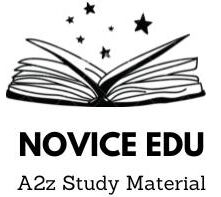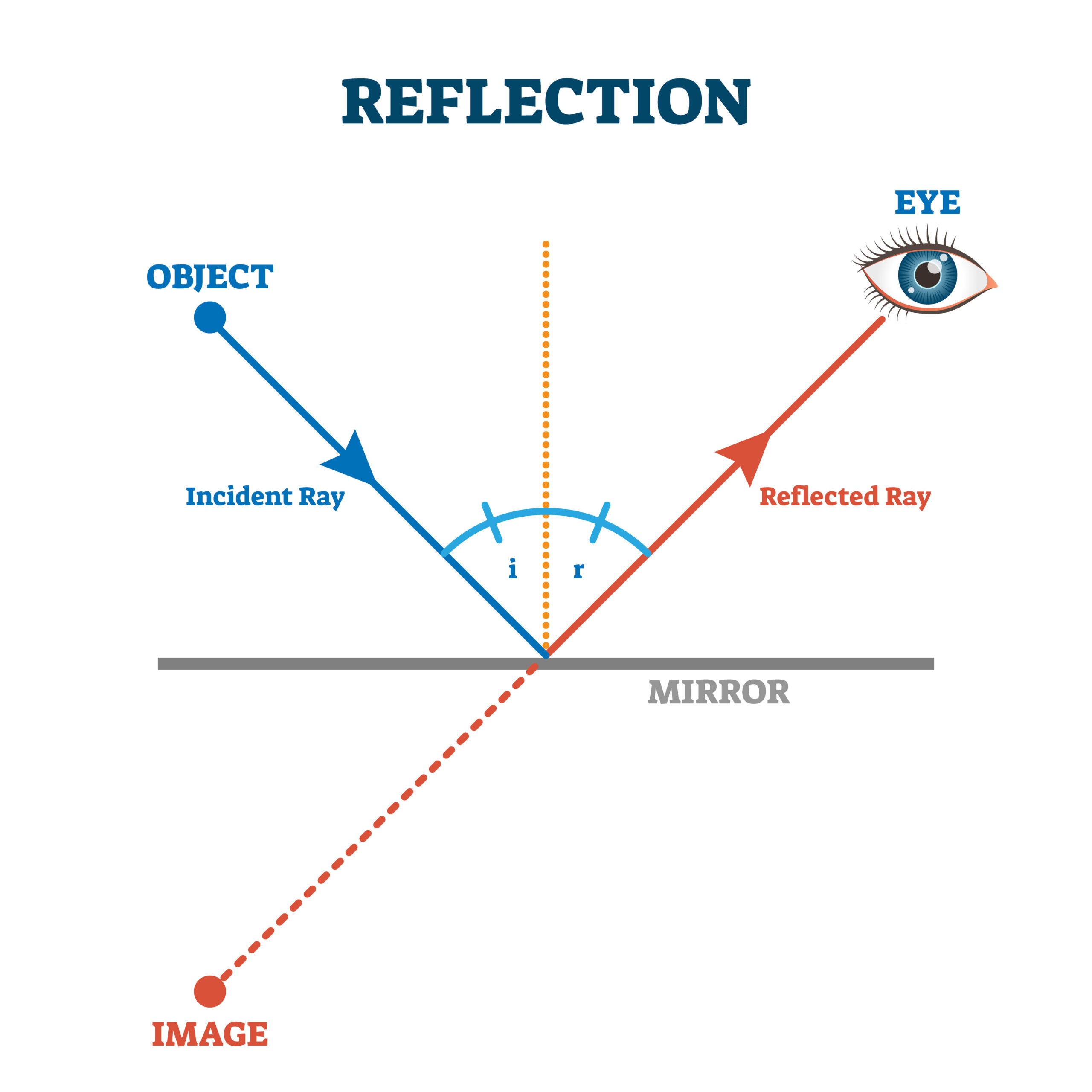Introduction to Light Class 10 Notes(class 10 science notes)
Light can be defined as energy that enables us to perceive objects. In other words, light moves in lines called rays and it’s observed to behave differently when encountering different materials or surfaces. Two main theories of light covered in this chapter are reflection and refraction which explain how it behaves upon travelling through various media.
Reflection of Light
Reflection is the situation when a ray of light strikes a surface and then bounces back into the same medium. This is seen in mirrors, shiny surfaces, and even calm water bodies. Through comprehension one can understand how images are made on mirrors and other reflecting apparatuses(class 10 science notes)
Laws of Reflection:
There are two fundamental laws governing the reflection of light:
The Angle of Incidence Equals the Angle of Reflection: When light strikes a surface, it does so at an angle (angle of incidence), which is equal to that at which it bounces off that surface (angle of reflection).
The Incident Ray, Reflected Ray, and Normal Lie in the Same Plane: There is a single plane containing the incident ray (incoming light), reflected ray (bounced light), and normal (the line perpendicular to the surface at the point where reflection occurs). (Light Class 10 Notes)(class 10 science notes)
Types of Reflection: (class 10 science notes)
Regular Reflection: This kind of happens on smooth surfaces such as mirrors; all rays are coherent with each other and can form clear images.
Diffuse Reflection: It happens on rough surfaces where reflection takes different directions hence making images either blur or absent.
Plane Mirrors:
Flat mirrors are reflective surfaces that create virtual images. A virtual image cannot be projected on a screen, as it seems to be at the back of a mirror. The following are some features of an image created by a plain mirror:
Virtual and Upright – The picture appears behind the mirror and is not inverted.
Same Size as the Object – The size of the object is equal to that of its reflection in the mirror.
Laterally Inverted – The right and left sides of this image are transposed.
Equal Distance – The distance from the object to the mirror is always equal to that from the image to it.
(Light Class 10 Notes)
Spherical Mirrors
These mirrors have curved surfaces and two types namely concave and convex mirrors. They are formed when you cut out a part of a sphere and their properties depend on how they curve.
Concave Mirrors:
Concave mirrors have a reflecting surface that curves inward like inside parts of a sphere. They bend light rays, thus useful for focusing light. When illuminations producing objects are at different locations from these mirrors, either real or virtual pictures can form through them. Real ones occur due to convergent light rays and can project upon screens.’ ( class 10 science notes)
Main Pointers for Concave Mirrors:
Actual and Upside-Down Picture: A real and upside-down picture is created when the object is placed beyond the focal point.
Imaginary and Magnified Image: When the object is put between the mirror and the focal point, a virtual, erect, and magnified image is formed.
Principle Focus (F): The place where parallel rays of light meet after they are reflected from a mirror.
Focal Length (f): It refers to the distance that lies between the pole (the center of curvature of the mirror) and focus.
Center of Curvature (C): Refers to a point that serves as the middle for any segment comprising an arc or two points on it. (Light Class 10 Notes)
Convex Mirrors:
These mirrors have a reflective surface that bulges outwards like the outer surface of a sphere. They diverge beams of light thus making them suitable for wide fields of vision such as in rearview mirrors in vehicles. Convex mirrors always create virtual, erect, diminished images regardless of an object’s position.
Main Characteristics of Convex Mirrors:
Virtual Image: They always form a virtual image that cannot be projected on a screen.
Reduced Image: The image formed is less than the actual object.
Large Field of View: They provide a larger field of view, therefore suitable for security and rearview needs.
Mirror Formula and Magnification:
The behavior of mirrors can be quantitatively understood by using the mirror formula and magnification which are important tools. (Light Class 10 Notes)
Mirror Equation:
Mirror equation states the relationship between object distance (u), image distance (v) and focal length (f) of the mirror:

This holds for both concave and convex mirrors, with distances’ nature depending on sign convention.
Magnification:
Magnification (M) is given by the ratio of height of the image (hi) to height of the object (ho):

A negative magnification shows an inverted image while positive magnification shows an upright image.
Refraction of Light
The bending of light when it moves from one medium to another with varying densities such as from air to water. This is because the speed of light varies with different media. (Light Class 10 Notes)
Laws of Refraction:
Refraction follows two basic laws:
The Incident Ray, Refracted Ray, and Normal Lie in the Same Plane: The incident ray (incoming light), refracted ray (bent light), and normal (line at right angles to the surface at the point where a beam of light strikes it) are in the same plane.
Snell’s Law: A ratio of sine i, angle of incidence to sine r, angle of refraction is constant. This ratio which is called as refractive index (n) determines how much it slows down light in a medium. (Light Class 10 Notes)

Refractive Index:
It shows how much slower the speed of light is in that medium vis-à-vis vacuum. It can be calculated as per the below equation,

Where
c is actually velocity involving mild within a Hoover along with
v is velocity involving gentle inside moderate.
When entering the medium, if there is a high refractive index it indicates that more bending will occur since there will be slow speed through this medium.
Critical Angle and Total Internal Reflection:
The angle at which light, when it changes from a denser material to a less dense one, bends on the boundary between the two substances with an angle of 90° is called the critical angle.
When the incident ray goes beyond the critical point, instead of refracting into another medium it is totally reflected back into its origin. It is this effect that makes optical fibers and periscopes work.
Lenses and Image Formation
Transparent materials having curved surfaces that cause refraction of light are called lenses. There are two main types of lenses; concave and convex. (Light Class 10 Notes)
Convex Lenses:
These lenses are thicker in the middle than at the edges, so they make parallel rays tend to converge or come together. The latter can form real images or virtual ones depending on where the object is relative to lens.
Key Features of Convex Lenses: (Light Class 10 Notes)
Key Features of Convex Lenses:
Converging Lens: A concave lens diverges parallel rays and focuses them at a point that is known as a focal point.
Real and Inverted Image: An object placed outside the focal length also forms a real image but inverted.
Virtual and Enlarged Image: If placed in front of its focal length it projects a virtual image that is erect and enlarged.
Concave Lenses:
It is known that concave lenses have a construction in which they are thinner in the center than at the edges and this makes the light to diverge. Perfect examples of such devices are peepholes or spectacles for short-sighted people and, in each case, virtual images are always upright and diminished.
Key Characteristics of Concave Lenses: (Light Class 10 Notes)
Key Characteristics of Concave Lenses:
Diverging Lens: To produce a convex lens parallel light rays are bent in a manner that they seem to come from a single point on the same side of the lens as the source of light.
Virtual Image: The final image is always virtual, erect, and smaller than the object under interrogation.
Lens Formula and Magnification: (Light Class 10 Notes)
The lens formula is the mathematical formula that describes how lenses behave and their magnification.
Lens Formula: (Light Class 10 Notes)
This equation connects the object distance (u), image distance (v), and focal length (f) of a lens:

This applies to both converging (convex) and diverging (concave) lenses, with the sign convention determining the kind of distances.
Magnification:
Magnification (M) is given by the ratio of hi to ho; (Light Class 10 Notes)

If M > 1, then an enlarged image is obtained while if M < 1 a diminished image is observed.
Power of a Lens:
The power of a lens (P) measures how much it can focus or disperse light; it’s equal to 1/f;

The unit for power is called a dioptre. Positive power means convex lens, while negative powers signify concave ones.
Applications of Reflection and Refraction
Reflections and refractions must be understood so that optical systems can be designed and natural phenomena interpreted appropriately. (Light Class 10 Notes)
Mirrors in Everyday Life:
Plane Mirrors: These are used in bathrooms, bedrooms, cars, etc. They form erect, virtual images that are sharp enough to recognize people’s faces. (Light Class 10 Notes)
Concave Mirrors: Such mirrors are employed in make-up mirrors as well as shaving mirrors or telescopes among others.

